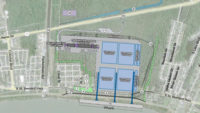Aside from the unexplained disqualification of one of four teams this spring, details on the much-anticipated $2.4-billion public-private partnership award to rebuild LaGuardia airport’s central terminal building (CTB) remain in a holding pattern.
Buffeted by recent negative press regarding "Bridgegate" and its organizational structure, the Port Authority of New York and New Jersey is tight-lipped, although work on the $3.5-billion renovation is expected to begin sometime this fall. “When we have something to announce, we will announce it,” a spokesman replied in an email to ENR, declining to respond to any other queries.
The agency last summer prequalified four teams vying for the LaGuardia Airport central-terminal renovation, which includes expanding it to 1.2 million sq ft from 750,000 sq ft. A group led by Mexico-based Grupo Aeroportuario del Sureste (ASUR) and investment firm Highstar Capital and including Fentress Architects and a joint venture of Hunt and VRH, announced in a terse press release that it had been disqualified by the port authority.
The remaining teams are:
• LaGuardia Gateway Partners, Queens, N.Y., which includes Skanska USA Building Inc.; Skanska USA Civil Northeast Inc.; Walsh Construction; Parsons Brinckerhoff; Hellmuth, Obata + Kassabaum PC; and Vantage Airport Group Ltd.
• LGAlliance, New York, which includes Lend Lease (US) Construction LMB Inc.; Turner Construction Co.; Gensler Architecture, Design & Planning P.C.; Macquarie Capital Group Ltd.; and Hochtief AirPort GmbH.
• LGA Central Terminal Consortium, which includes GS Infrastructure Partners II; Aeroports de Paris; TAV Havalimanlari Holdings A.S.; Tutor Perini Corporation; Zachry Construction Corporation; O&G Industries, Inc.; Ove Arup & Partners, PC; Kohn Pedersen Fox Associates PC.
The CTB program, estimated to cost over $3 billion, includes demolishing the existing CTB and its four concourses, garage, Hangar 1 and frontage roads; building temporary facilities; and designing and building a new CTB. It also includes constructing a central heating and refrigeration plant, utilities for the new building and hydrant fueling within the project site's limits, as well as operating, maintaining and managing the existing CTB and temporary facilities during construction.
In a talk given to the Transportation Research Forum last September, agency Executive Director Pat Foye said that, while related road infrastructure will increase to 4,400 linear ft from 3,000 linear ft, the number of gates will remain at 35. “We will have the same number of gates, but they will be able to accommodate larger planes,” he said.
The agency has had previous experience working with private developers. In 1996, it awarded a $1-billion contract, then called “build-own-operate-transfer,” to a team including then-Fluor Daniel as construction-program manager and then-Morse Diesel International Inc. as contractor to build a new international arrivals terminal at John F. Kenney International Airport. Rent from new shops and other concessions, as well as airport taxes and landing fees, covered the project cost.
In an ENR interview in February discussing the agency’s expanding use of P3s for bridge projects as well as for LaGuardia, port authority chief engineer Peter Zipf said, “For LaGuardia, we are working with the private developers, who will work with the airlines.” Details regarding developer payments and responsibilities are still unclear.
Michael Schneider, a senior vice president with HDR Inc., observes that, in general, for a P3 airport terminal rebuild, “revenue sources may not be enough to cover the cost of the project. Will supplemental public funding be sufficient when paired with the revenue stream that the project will generate?” He adds, however, that as a cross between “social infrastructure” (buildings) and transportation infrastructure, airport terminal P3s have less revenue risk than either type alone. “On these kind of projects, the revenue risk is typically less than, say, a toll road,” he notes.



Post a comment to this article
Report Abusive Comment